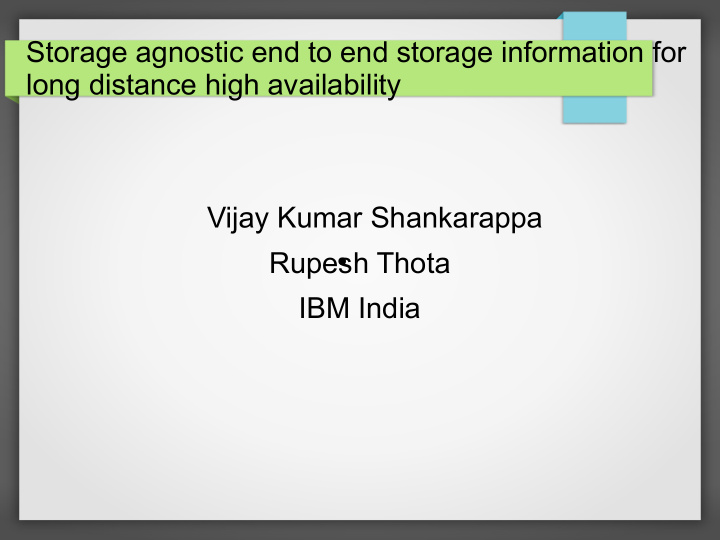



Storage agnostic end to end storage information for long distance high availability Vijay Kumar Shankarappa Rupesh Thota ● IBM India
Contents 1) High availability/Recovery solutions 2) Long distance availability challenges 3) Proposal
Cluster High availability vs VM Restart High availability VM Restart HA Solution Cluster HA Solution India USA Site 1 Site 2 Systems Mgr Systems mgr Manager cluster HA Cluster Network VM7 VM8 Storage Hypervisor VM1 VM2 Storage Hypervisor Host Mirroring Site 1 … Site 2 … Restart LPARs Fiber VS System 2 Synchronous System 1 Storage Mirroring Asynchronous Storage Mirroring Replicated Storage
Economical and Simplified HA models System 2 System 1 Failover HA HA Cluster Cluster … … Node 2 Node 1 Standby Active HA Cluster Infrastructure Fault Tolerance Fig 1: Cluster High Availability Cluster HA Availability Critical Vm Restart workloads HAManager VM HA Non- Critical System 2 System 1 workloads Single Restart Server Restarted VM 1 VM 1 … … VM 1 Technology complexity Fig 2: VM Restart High Availability
Comparison of Cluster fail-over versus VM restart Cluster Availability VM (Restart) High Availability Faster Reinit & Reboot of VM Workload Startup time Yes No Cluster Administration (Network, Storage, Security) Error coverage Comprehensive Limited (inside VM monitors) (outside VM Monitors) Deployment Simplicity Needs setup in each VM Aggregated deployment outside VMs No Yes License & Resource Savings Workload Type protected Critical Non-Critical Validation Hard Easily audited Flexible failover policies No Yes
VM restart HA: Challenges How to identify physical storage in use by a particular VM or a set of VMs which needs to be highly available ? How to help admin configure physical storage data replication - Peer to Peer Remote Copy (PPRC) pairs across multiple sites ? No SCSI standards to deal with PPRC. PPRC is vendor specific implementation today. Availability solutions hard to meet in a repeatable manner.
End to End flows in VM restart HA Virtual storage: Storage hypervisors on a host system present physical storage accessible to it to the virtual machines via NPIV - Nport ID virtualization or virtual SCSI ( Backed by a File or a logical volume or a complete disk or a Clustered file system Logical unit ) ● First task : Need to collect all the virtual storage mapped for a VM or VM group. ● Next task is to find the backing physical storage (disks) ● Next task is to help admin configure storage mirroring on alternate site based on consolidated virtual/physical storage information collected by storage hypervisor at source site. ● Next task is to validate/find the physical and virtual storage availability on alternate site. ● Initiate site movement by admin in case of real incident. ● Cleanup the virtual mappings/VMs once DR site is back up.
Comparison: Methodology for storage data collection in VM HA In Band - storage hypervisor Out of band – external orchestrator/manager/agent Single device agnostic Custom code/modules for each code/module to fetch data, storage vendor/product/revisions abstracts vendor/product/revisions Efficient design since hypervisor Go to storage hypervisor to fetch owns the virtual device mappings the virtual mappings, and then for a VM , gets the required data query for each backing device for only those backing devices based on storage type. quicker More robust as it also Less scalable as it turns out to be understands/handles MPIO for the multiple commands/scripts to get storage it provisions. the MPIO and collate the virtual and physical mappings. Easily extensibile with growing Need to write new code to feature-set in virtual storage accommodate any changes in hypervisor. storage hypervisor features.
In Band data collection by storage hypervisor – SCSI standards and status as of today Page 80h for appliance/array identifier Page 83h to get Logical unit identifier Vendor specific pages to get globally unique device/volume identifiers used for mirroring. Vendor specific pages to read PPRC (copy relationships and status) Changes for each storage vendor, models, revisions. Dependency on vendor tools/api/cli to get the same info.
SCSI standards proposal T10 SPC4 r361 onwards, proposal on Vital product data parameters ● http://www.t10.org/cgi-bin/ac.pl?t=f&f=spc4r36l.pdf ● Device constituents Page Code: 8Bh , section 7.8.5 ● Currently optional in SPC4 ●
SCSI standards proposal Constituent Device Identification VPD page code (83h) - part of Page 8Bh If the designator type is 3h (i.e., NAA identifier), this format is compatible with the Name_Identifier format defined in FC-FS-3. The Name Address Authority (NAA) field defines the format of the NAA specific data in the designator.
Globally Unique identifier of a disk can be defined using this format using a 16 byte designator and used for configuring mirroring.
SCSI inquiry page/constituent to hold PPRC data A new inquiry page to be defined to hold PPRC data in SCSI specification - To have all the relevant mirroring information. 1) PPRC state ● Is full duplex ● Is duplex pending (Copy to establish the pair in progress) ● PPRC pair is suspended 2) PPRC status ● Status of copy operations along with partner volume id 3) Mirrored array info : ● model, vendor, revision info Reference : IBM FICON/ESCON attachment specification has defined a page C0 to hold such data.
Takeaway: Design point ====> VM restart availability solutions easier to implement in a repeatable and storage agnostic manner if: a) Globally unique disk identifiers are used in PPRC pairs, b) PPRC partners and status info is standardized via SCSI inquires, c) Adopted by all storage vendors uniformly.
Recommend
More recommend